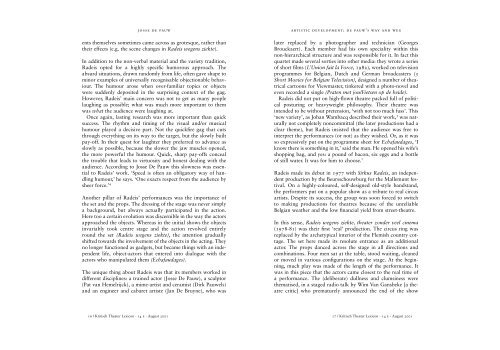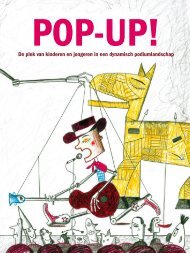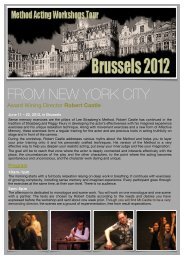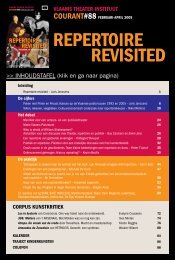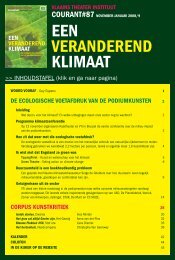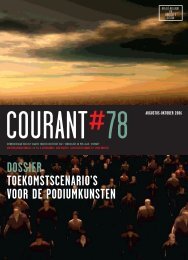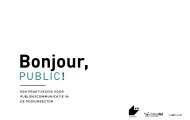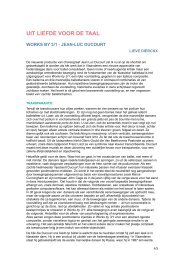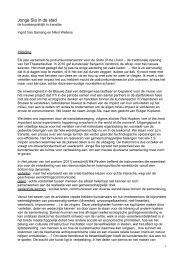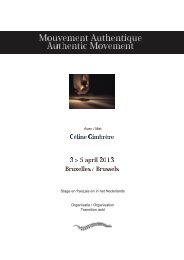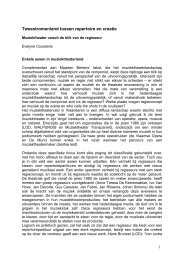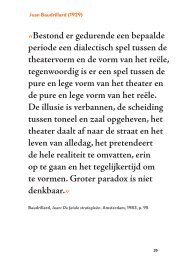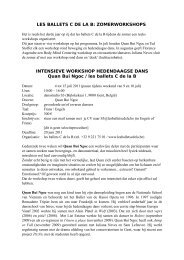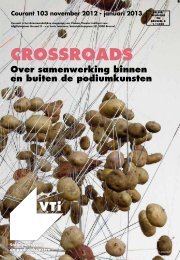Create successful ePaper yourself
Turn your PDF publications into a flip-book with our unique Google optimized e-Paper software.
josse de pauw<br />
ents themselves sometimes came across as grotesque, rather than<br />
their effects (e.g. the scene changes in Radeis wegens ziekte).<br />
In addition to the non-verbal material and the variety tradition,<br />
Radeis opted for a highly specific humorous approach. The<br />
absurd situations, drawn randomly from life, often gave shape to<br />
minor examples of universally recognisable objectionable behaviour.<br />
The humour arose when over-familiar topics or objects<br />
were suddenly deposited in the surprising context of the gag.<br />
However, Radeis’ main concern was not to get as many people<br />
laughing as possible; what was much more important to them<br />
was what the audience were laughing at.<br />
Once again, lasting research was more important than quick<br />
success. The rhythm and timing of the visual and/or musical<br />
humour played a decisive part. Not the quickfire gag that cuts<br />
through everything on its way to the target, but the slowly built<br />
pay-off. In their quest for laughter they preferred to advance as<br />
slowly as possible, because the slower the jaw muscles opened,<br />
the more powerful the humour. Quick, sharp pay-offs conceal<br />
the trouble that leads to virtuosity and honest dealing with the<br />
audience. According to Josse <strong>De</strong> <strong>Pauw</strong> this slowness was essential<br />
to Radeis’ work. ‘Speed is often an obligatory way of handling<br />
humour,’ he says. ‘One exacts respect from the audience by<br />
sheer force.’ 4<br />
Another pillar of Radeis’ performances was the importance of<br />
the set and the props. The dressing of the stage was never simply<br />
a background, but always actually participated in the action.<br />
Here too a certain evolution was discernible in the way the actors<br />
approached the objects. Whereas in the initial shows the objects<br />
invariably took centre stage and the action revolved entirely<br />
round the set (Radeis wegens ziekte), the attention gradually<br />
shifted towards the involvement of the objects in the acting. They<br />
no longer functioned as gadgets, but became things with an independent<br />
life, object-actors that entered into dialogue with the<br />
actors who manipulated them (Echafaudages).<br />
The unique thing about Radeis was that its members worked in<br />
different disciplines: a trained actor (Josse <strong>De</strong> <strong>Pauw</strong>), a sculptor<br />
(Pat van Hemelrijck), a mime-artist and ceramist (Dirk <strong>Pauw</strong>els)<br />
and an engineer and cabaret artiste (Jan <strong>De</strong> Bruyne), who was<br />
16 / Kritisch Theater Lexicon - 14 e - August 2001<br />
artistic development: de pauw’s way and weg<br />
later replaced by a photographer and technician (Georges<br />
Brouckaert). Each member had his own speciality within this<br />
non-hierarchical structure and was responsible for it. In fact this<br />
quartet made several sorties into other media: they wrote a series<br />
of short films (L’Union fait la Force, 1982), worked on television<br />
programmes for Belgian, Dutch and German broadcasters (3<br />
Short Movies for Belgian Television), designed a number of theatrical<br />
cartoons for Viewmaster, tinkered with a photo-novel and<br />
even recorded a single (Praten met jou/Fietsen op de heide).<br />
Radeis did not put on high-flown theatre packed full of political<br />
posturing or heavyweight philosophy. Their theatre was<br />
intended to be without pretension, ‘with not too much fuss’. This<br />
‘new variety’, as Johan Wambacq described their work, 5 was naturally<br />
not completely noncommittal (the later productions had a<br />
clear theme), but Radeis insisted that the audience was free to<br />
interpret the performances (or not) as they wished. Or, as it was<br />
so expressively put on the programme sheet for Echafaudages, ‘I<br />
know there is something in it,’ said the man. He opened his wife’s<br />
shopping bag, and yes: a pound of bacon, six eggs and a bottle<br />
of still water. It was for him to choose.’<br />
Radeis made its debut in 1977 with Sirkus Radeis, an independent<br />
production by the Beursschouwburg for the Mallemunt festival.<br />
On a highly-coloured, self-designed old-style bandstand,<br />
the performers put on a popular show as a tribute to real circus<br />
artists. <strong>De</strong>spite its success, the group was soon forced to switch<br />
to making productions for theatres because of the unreliable<br />
Belgian weather and the low financial yield from street-theatre.<br />
In this sense, Radeis wegens ziekte, theater zonder veel cinema<br />
(1978-81) was their first ‘real’ production. The circus ring was<br />
replaced by the arc<strong>het</strong>ypical interior of the Flemish country cottage.<br />
The set here made its resolute entrance as an additional<br />
actor. The props danced across the stage in all directions and<br />
combinations. Four men sat at the table, stood waiting, cleaned<br />
or moved in various configurations on the stage. At the beginning,<br />
much play was made of the length of the performance. It<br />
was in this piece that the actors came closest to the real time of<br />
a performance. The (deliberate) dullness and clumsiness were<br />
thematised, in a staged radio talk by Wim Van Gansbeke [a theatre<br />
critic] who prematurely announced the end of the show<br />
17 / Kritisch Theater Lexicon - 14 e - August 2001


